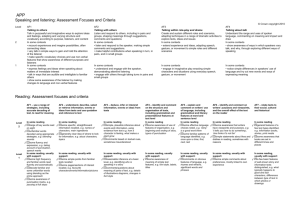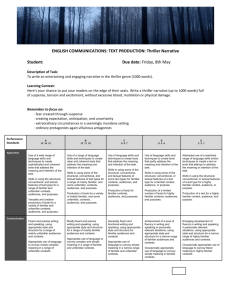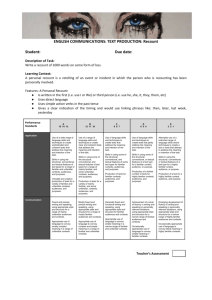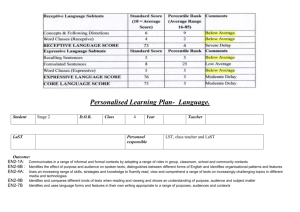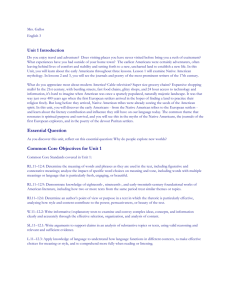Task 1
advertisement
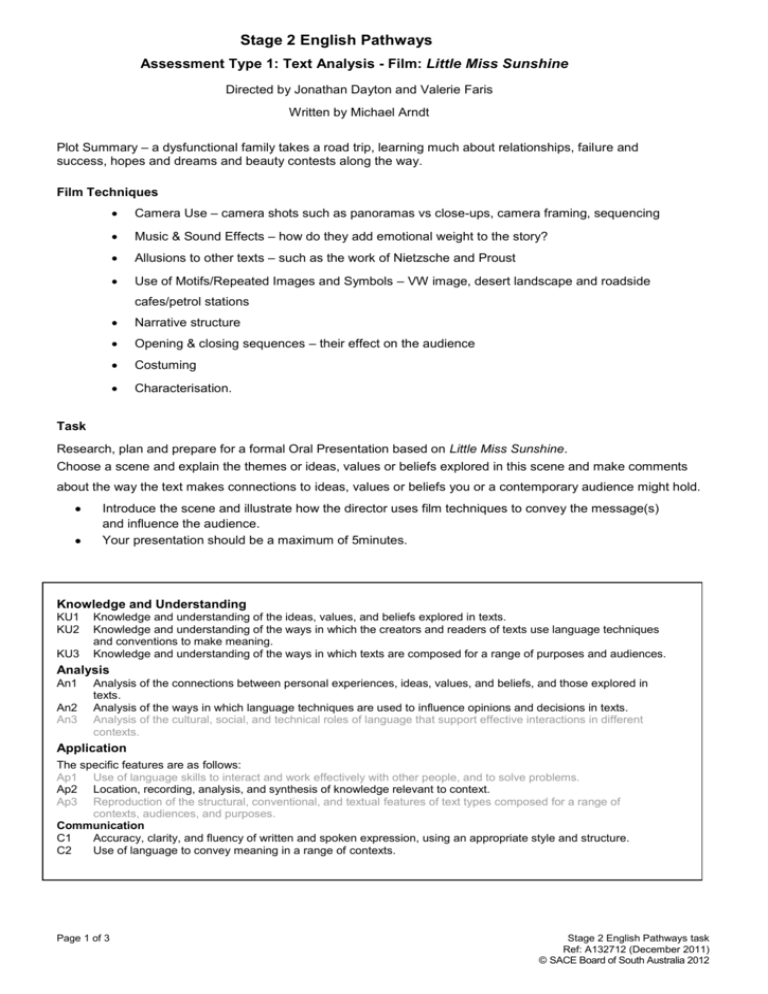
Stage 2 English Pathways Assessment Type 1: Text Analysis - Film: Little Miss Sunshine Directed by Jonathan Dayton and Valerie Faris Written by Michael Arndt Plot Summary – a dysfunctional family takes a road trip, learning much about relationships, failure and success, hopes and dreams and beauty contests along the way. Film Techniques Camera Use – camera shots such as panoramas vs close-ups, camera framing, sequencing Music & Sound Effects – how do they add emotional weight to the story? Allusions to other texts – such as the work of Nietzsche and Proust Use of Motifs/Repeated Images and Symbols – VW image, desert landscape and roadside cafes/petrol stations Narrative structure Opening & closing sequences – their effect on the audience Costuming Characterisation. Task Research, plan and prepare for a formal Oral Presentation based on Little Miss Sunshine. Choose a scene and explain the themes or ideas, values or beliefs explored in this scene and make comments about the way the text makes connections to ideas, values or beliefs you or a contemporary audience might hold. Introduce the scene and illustrate how the director uses film techniques to convey the message(s) and influence the audience. Your presentation should be a maximum of 5minutes. Knowledge and Understanding KU1 KU2 KU3 Knowledge and understanding of the ideas, values, and beliefs explored in texts. Knowledge and understanding of the ways in which the creators and readers of texts use language techniques and conventions to make meaning. Knowledge and understanding of the ways in which texts are composed for a range of purposes and audiences. Analysis An1 An2 An3 Analysis of the connections between personal experiences, ideas, values, and beliefs, and those explored in texts. Analysis of the ways in which language techniques are used to influence opinions and decisions in texts. Analysis of the cultural, social, and technical roles of language that support effective interactions in different contexts. Application The specific features are as follows: Ap1 Use of language skills to interact and work effectively with other people, and to solve problems. Ap2 Location, recording, analysis, and synthesis of knowledge relevant to context. Ap3 Reproduction of the structural, conventional, and textual features of text types composed for a range of contexts, audiences, and purposes. Communication C1 Accuracy, clarity, and fluency of written and spoken expression, using an appropriate style and structure. C2 Use of language to convey meaning in a range of contexts. Page 1 of 3 Stage 2 English Pathways task Ref: A132712 (December 2011) © SACE Board of South Australia 2012 Performance Standards for Stage 2 English Pathways A Knowledge and Understanding Analysis Application Communication Detailed knowledge and understanding of the ideas, values, and beliefs in familiar and unfamiliar texts. Detailed analysis of complex connections between personal experiences, ideas, values, and beliefs, and those explored in familiar and unfamiliar texts. Use of a comprehensive range of language skills to interact effectively in different contexts, and to analyse and solve simple and complex problems. Fluent and precise writing and speaking, using an appropriate style and structure for a range of mainly unfamiliar audiences and contexts. Perceptive analysis of a range of ways in which authors use language techniques to influence opinions and decisions in familiar and unfamiliar texts. Location, recording, analysis, and synthesis of knowledge relevant to familiar and unfamiliar contexts. Appropriate use of language to convey mostly complex meaning in a range of familiar and unfamiliar contexts. Knowledge and understanding of the ways in which the creators and readers of familiar and unfamiliar texts use a range of language techniques to make meaning. B Comprehensive knowledge and understanding of the ways in which familiar and unfamiliar texts are composed for a range of purposes and audiences. Perceptive analysis of aspects of familiar and unfamiliar cultural, social, and technical roles of language that support effective interactions in different contexts. Sound knowledge and understanding of some ideas, values, and beliefs in familiar, and some unfamiliar, texts. Analysis of some complex connections between personal experiences, ideas, values, and beliefs, and those explored in familiar, and some unfamiliar, texts. Knowledge and understanding of the ways in which the creators and readers of mainly familiar texts use some language techniques to make meaning. Sound knowledge and understanding of the ways in which mainly familiar texts are composed for some purposes and audiences. C Knowledge and understanding of some ideas, values, or beliefs in familiar texts. Knowledge and understanding of the ways in which the creators and readers of a narrow range of familiar texts use some language techniques to make meaning. Knowledge and understanding of the ways in which familiar texts are composed for familiar purposes and audiences. Page 2 of 3 Well-considered analysis of a range of ways in which authors use language techniques to influence opinions and decisions in familiar, and some unfamiliar, texts. Well-considered analysis of aspects of mainly familiar, and some unfamiliar, cultural, social, or technical roles of language that support effective interactions in different contexts. Competent analysis of simple connections between personal experiences, ideas, values, or beliefs, and those explored in familiar texts. Descriptive analysis of a number of ways in which authors use language techniques to influence opinions and decisions in familiar texts. Competent analysis of some aspects of mainly familiar cultural, social, or technical roles of language that support effective interactions in different contexts. Sophisticated skills in reproducing the structural, conventional, and textual features of text types for a range of familiar and unfamiliar contexts, audiences, and purposes. Use of a sound range of language skills to interact effectively in different contexts, and to solve simple and complex problems. Mostly fluent and precise writing and speaking, using an appropriate style and structure for a range of mostly familiar audiences and contexts. Location, recording, analysis, and occasional synthesis of knowledge relevant to mostly familiar contexts. Appropriate use of language to convey complex and simple meaning in a range of familiar, and some unfamiliar, contexts. Sound skills in reproducing some of the structural, conventional, and textual features of text types for a range of mainly familiar, and some unfamiliar, contexts, audiences, and purposes. Use of competent language skills to interact effectively in different contexts, and to solve routine problems in familiar contexts. Location, recording, and occasional analysis of knowledge relevant to a familiar context. Skills in reproducing some of the structural, conventional, and textual features of some text types for familiar contexts, audiences, and purposes. Generally clear and accurate writing and speaking, using an appropriate style and structure for familiar audiences and contexts. Appropriate use of language to convey simple meaning in a narrow range of familiar and unfamiliar contexts. Stage 2 English Pathways task Ref: A132712 (December 2011) © SACE Board of South Australia 2012 D Knowledge and Understanding Analysis Application Communication Identification of some simple ideas, values, or beliefs in some familiar texts. Reference to simple connections between uncomplicated personal experiences, ideas, values, or beliefs, and those explored in familiar texts. Use of a restricted range of language skills to interact in familiar contexts, and to solve simple problems. A level of fluency in writing and speaking in personally relevant situations, using an appropriate style and structure for a narrow range of familiar audiences and contexts. Knowledge and understanding of the ways in which the creators and readers of a narrow range of familiar texts use a restricted range of language techniques to make simple or factual meaning. E Reference to some ways in which authors use language techniques to influence opinions and decisions in familiar texts. Knowledge of the ways in which familiar texts are composed for personally relevant purposes and familiar audiences. Reference to some simple aspects of familiar cultural, social, or technical roles of language that support effective interactions in one or more contexts. Identification of a simple idea, value, or belief in a familiar text. Recognition of a simple connection between a straightforward personal experience, idea, value, or belief, and that explored in a highly familiar text. Some knowledge and emerging understanding of the way in which a creator or reader of a highly familiar text uses a language technique to make factual meaning. Some knowledge of the ways in which highly familiar texts are composed for personally relevant purposes and highly familiar audiences. Page 3 of 3 Reference to the way in which an author uses language techniques to influence opinions and decisions in a highly familiar text. Recognition of some simple aspects of highly familiar cultural, social, or technical roles of language that support effective interactions in one or more contexts. Location and recording of factual knowledge relevant to a familiar context. Limited skills in reproducing some of the structural, conventional, or textual features of a text type for a familiar context, audience, or purpose. Use of a restricted range of language skills to interact in highly familiar contexts, and to solve simple problems. Location or recording of factual knowledge relevant to a highly familiar context. Restricted skills in reproducing a limited number of structural, conventional, or textual features of a text type for a highly familiar context, audience, or purpose. Occasionally appropriate use of language to convey simple meaning in familiar contexts. Emerging development of fluency in writing and speaking in personally relevant situations, using an appropriate style and structure for a narrow range of highly familiar audiences and contexts. Occasionally appropriate use of language to convey literal meaning in highly familiar contexts. Stage 2 English Pathways task Ref: A132712 (December 2011) © SACE Board of South Australia 2012

